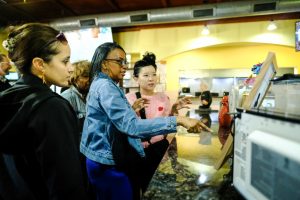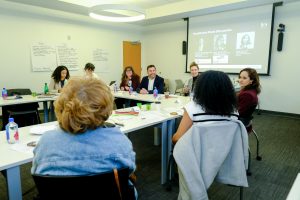Post From Expert Insights
In April 2025, Build Healthy Places Network (BHPN) convened awardees of its Community Innovations for Racial Equity (CIRE) initiative in St. Louis, MO, for a transformative in-person gathering. With generous support from The Kresge Foundation, CIRE fosters collaboration and capacity building among BIPOC-led and allied Community Development Corporations (CDCs) to advance health and racial equity. This convening aimed to strengthen connections, foster trust, and facilitate peer-to-peer learning, all crucial for advancing community-led solutions.
Specifically, CIRE awardees from Riverside, CA; Sicangu Lakota Nation, SD; St. Louis, MO; Providence, RI; and Camden, NJ joined BHPN staff for two days of immersive community building and engagement. Co-hosted by Beyond Housing of St. Louis, a CIRE awardee.
A key element of the convening was highlighting the St. Louis community. BHPN engaged local, Black-owned businesses like TJS Photography to support the local economy and provide authentic dialogue about community engagement models.
Day two of the CIRE convening offered a powerful glimpse into the tangible impact of community-led development, thanks to a guided tour provided by Chris Krehemeyer, CEO of Beyond Housing. The journey began at the revitalized 24:1 Cinema, which transformed an underused building into a vibrant community hub offering entertainment, event space, and a gathering spot for locals. Next, the cohort explored Carter Commons Food Hall, a dynamic space featuring minority-owned businesses. Beyond Housing also showcased their acquisition and rehabilitation program, revitalizing homes, increasing housing stock, and supporting homeownership.

CIRE awardees enjoy local sweet treats in Dutchtown Neighborhood. Photo credit: TJS Photography
Beyond Housing openly shared the challenges, like recruiting a community grocery store operator, offering a realistic view of community development. Throughout the tour, it was clear each project was driven by community voices and priorities. Krehemeyer emphasized Beyond Housing’s transformational approach, addressing community-identified needs rather than transactional development. This commitment resonated deeply with the CIRE cohort, demonstrating the power of intentional redevelopment.
As the CIRE cohort gathered in St. Louis, a crucial theme emerged: the real-world impact of recent federal cuts on how these cuts impact organizations addressing systemic barriers to health and prosperity in their communities. This reflection laid the groundwork for deeper discussions and crystallized into key takeaways that will guide our collective work moving forward.

Panel with local hospital system representatives Christopher M. Nolan (BJC HealthCare) and Karen L. Bradshaw (SSM Health) Photo credit: TJS Photography
The journey continues! Building on the powerful connections forged in St. Louis, we’re thrilled to launch the CIRE Learning Action Lab, bringing together members of the awardee cohort. This collaborative initiative will drive the creation of cutting-edge resources for CDCs seeking to shift power to more community-led approaches through multisector partnerships.
Ready to be part of the movement? We invite you to witness the impact of this groundbreaking convening by watching our recap video. More importantly, discover and support the vital work being led by each CIRE cohort member as they strive to build more just, healthy, and prosperous communities. If your organization is passionate about learning from and supporting multi-sector collaborations, we urge you to connect with us and explore how we can work together to create lasting change. Join us in shaping the future of equitable community development!